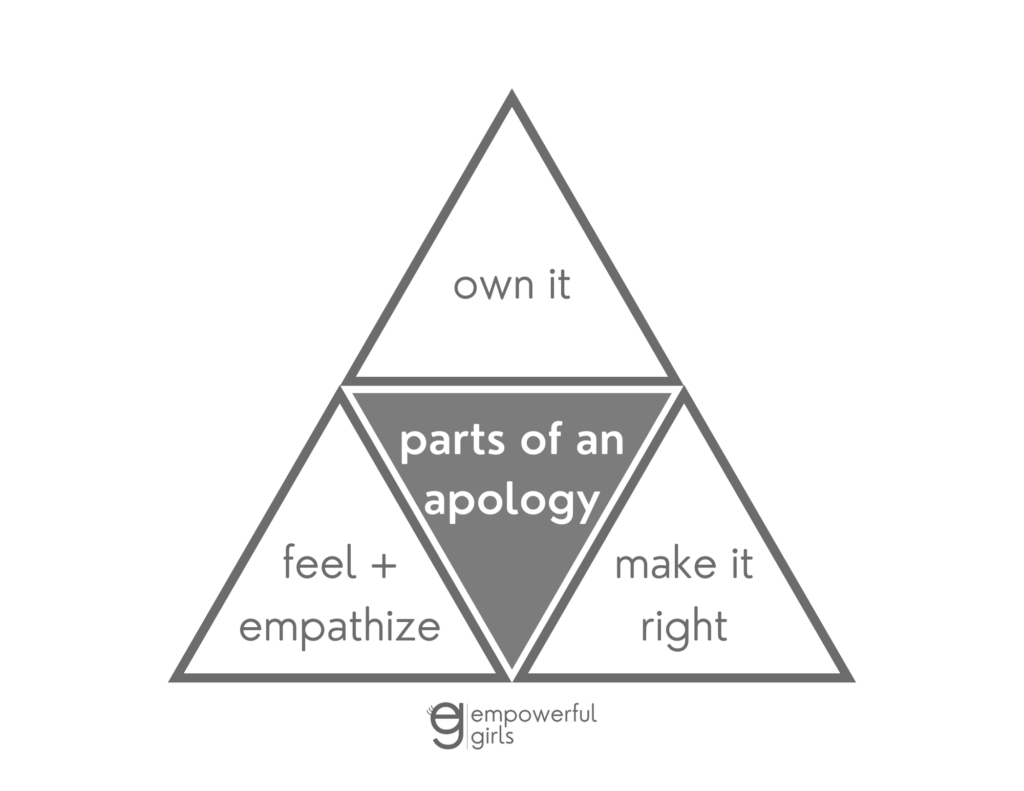
Saying Sorry
Back in episode 009 we discussed Forgiveness — remember, the goal with forgiveness is to find peace within yourself.
But what if you are the one at fault? We’re gonna flip the conversation and explore Apologies.
Now hold on, isn’t it as easy as just saying, “Sorry”? Nope!
Hear that, Justin Bieber? It’s not.
Parts of an Apology
That is, if you really mean it. There is an art to apologizing. Psychologist Robert Gordon outlined the parts of an apology (some people break it up into six parts, but three’s easier to remember). Here are your Apology Tools, Gordon’s three-part apology explained for you:
1. Own It – say what you did wrong. For example: “I’m sorry that I …” notice how I keep saying I, because it’s my apology for my part of what happened.
What if I don’t think what I did was wrong, yet someone still felt hurt by it? Bad example: “I’m sorry IF you feel that way, that’s not what I meant” doesn’t really sound like I’m sorry at all, and shifts the fault off me. Intentions aren’t as important as impact. So even though I didn’t intend to hurt someone or their feelings, me saying that doesn’t erase their pain — it might even make it hurt worse. No IF’s in apologies.
2. Feel and Empathize – express how you truly feel bad for what you did, and recognize the other person’s feelings. Remember how we discussed Empathy in Ep. 007 — to feel with someone else. For example: “I feel awful about what happened, and can understand why you’re upset.”
What if the other person is partly to blame? Bad example: “I’m sorry that I … BUT you were …” or “BUT I just …” Again, doesn’t really sound like I’m sorry. Remember, this is my apology — I can’t force someone to apologize too or forgive me, but I can control my own actions. Avoid the urge to excuse, justify, or shift blame for what happened. This is not about me being right; I’m apologizing for something I did wrong. No BUT’s in apologies.
3. Make It Right – say what you’ll do differently, or think about/ask what you can do to help make it up to them — and mean it. For example: “From now on I will …” This is my apology for my actions, and my responsibility to rebuild trust.
What if I think I’ll make the same mistake again? Hopefully your apology was heartfelt, you meant it. But people aren’t perfect and we all make mistakes, so there’s a chance you’ll need to apologize again. And again. That doesn’t mean you shouldn’t try and just give up. Every day, try harder to do better and to choose better. When we were kids, my closest brother and I used to butt heads a lot: he’d tease me, I’d try to get him back, we’d apologize, he’d tease me, the cycle repeated. But as we tried harder, and got older, we started treating each other better and didn’t need to apologize as much. So keep trying anyway and apologize when you need to!
What to Apologize For
What sort of things should I apologize for? I’ll refer back ep. 012 for examples of how Friendship Fires start:
- Leaving someone out
- Name-calling
- Talking behind someone’s back
- Acting bossy
- Telling secrets
- Sharing something that was private
- Making fun
- Not inviting someone
- Having a disagreement
- Selfishness
- Dishonesty
- Being a poor sport
- Bragging
- Jealousy
- Spreading gossip or rumors
And I’ll add: - Getting angry, lashing out
- Breaking someone’s trust
- Doing/saying something unkind, on purpose or by accident
- When someone lets you know (by telling or showing you) you’ve hurt them
More About Apologies
When should I apologize? Sociologist Martha Beck said “The perfect moment to apologize is the moment you realize you’ve done something wrong.” Timing is really important, and while some scenarios may need some time for dust to settle and emotions to calm down, an apology is most effective when it’s given as soon as possible. So as soon as you can apologize and truly mean it, you should do it.
How should I apologize? I think the best way is to do it is in-person, face to face, where you can see each other’s expressions and emotions, and repair and rebuild trust most effectively. Sometimes face to face isn’t an option, or isn’t ideal. Next best, I’d say video call, followed by phone call. Again, being able to see or at least hear someone share their feelings is preferred. If you must text or email, stick to the 3-part format and watch your tone — emotions are so much harder to get across through text/email. And while emojis may seem like a substitute for your emotions, they don’t always translate and don’t automatically make everything better. Explain in your text/email that you hope to talk in-person soon, and when you do, apologize face to face.
What happens next? Give it time — you don’t give an apology only to get forgiveness in return. You can’t force forgiveness from them, or make them apologize, too, but you can forgive yourself. Apologizing doesn’t reset or fix everything. You said you’d do better, so do.
Working up the courage to apologize is hard. When you know you’ve done something wrong, there’s this weight on your shoulders, a pit in your stomach, a gnawing and nagging, a dread that occupies your thoughts as you debate about what to do next. Whether the person you hurt is a family member, your best friend, a stranger, or someone who’s not your friend, I believe you’ll feel so much better if you Apologize: Own It, Feel and Empathize, and Make It Right.
Apology Poster Printable
To help you with this, I created an “Apology” poster for you to print out, personalize, and post on your wall where you’ll see it, remember it, practice it, and believe it — that’s the important part.
Resources
Here are few of my favorite books that illustrate apologizing:
Zach Apologizes, by William Mulcahy
Desmond and the Very Mean Word, by Desmond Tutu
This is Just to Say: Poems of Apology and Forgiveness, by Joyce Sidman (written by 6th graders)
If you have a topic suggestion, I’d love to hear from you! Send an email (tweens get the OK from your parents) to hello@EmpowerfulGirls.com .
If you have social media already, follow me on Insta or tiktok @empowerfulgirls. I’m not encouraging or endorsing social media, but I’m on there to offer an unfiltered, uplifting alternative to what’s in your feed. Remember to get on the email list for the newsletter!
Also, if you enjoy listening to 10 for Teens + Tweens, I would truly appreciate you telling your friends about this podcast or leaving a review so others can find it and feel uplifted, too! Your support means the world to me!
